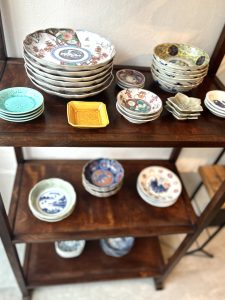季節外れのソメイヨシノの桜(愛知県名古屋市千種区姫池通 骨董買取 古美術風光舎)
2024.10.19
皆さまこんにちは。スタッフHでございます。
名古屋は昼から雨が降り始めております。今朝はかなり蒸し暑く、今は秋ですよね?と呟いてしまうほど季節の感覚を失いそうです。

戸惑っているのは人間だけではないようで、東京の上野公園のソメイヨシノの桜が一部季節外れの花を咲かせているそうです。
「桜開花宣言!」をいち早く伝えることを使命としている(?)阿部祐二レポーターが、さすがに今宣言するのは難しそうです…と残念そうでした。
この現象は数年前から起こっているようで、何らかの影響で落葉が早まり、花の成長を抑える植物ホルモンの働きが弱まったためと考えられています。
桜は7、8月には既に花の芽ができており、葉が残っているうちは花の成長を抑える植物ホルモン「アブシシン酸」が葉から送り込まれますが、葉が落ちた後はホルモンの供給が止まり春が来るのを待つことになります。しかし落葉後、気温が上がると秋でも花が咲くことがあるのだとか。
もともと年に2回桜の花を咲かせる「十月桜」という品種があり、上野公園の清水観音堂の近くにも植えられています。江戸時代後期から栽培されている桜で、10月下旬から12月まで咲いていることが多いそうです。
ひっそりと奥ゆかしく咲いているので、気付かれないことも多いそうですが、この桜を楽しみに足を運ぶ方もいらっしゃるとか。
しかし十月桜のようにこの季節外れに咲く花は「徒花(あだばな)」とも呼ばれ、「咲いても実を結ばない花」「咲いてもすぐに散る花」など切ないイメージをもたれています。人間のために咲いている訳ではないのに勝手な呼び方をされ、さぞ迷惑なことでしょう。
さらに、咲くはずのない時期に咲いているソメイヨシノの花。桜好きの日本人が不審な目で眺めてしまうのですから気の毒な気持ちになります。
本来桜の落葉は11月中旬から12月上旬で、落葉が早まる要因として、夏場の極端な高温や土壌の乾燥などが指摘されています。葉が落ちてすぐに開花することはないので、9月頃に何かしらの原因で落葉したのではないかと考えられています。9月頃といえば、例年にない猛暑でございました。植物は人間以上に環境の変化に敏感に反応している気がします。
植物だけではなく近年は温暖化の影響により、海の魚の大移動が起こっているといわれています。
瀬戸内海や西日本が主な産地だったフグ類やタチウオの生息地に大きな変化が見られ、ここ数年フグは北海道が漁獲量で1位になり、タチウオは東北地方で水揚げが増えているとのこと。
そして北海道の函館のスルメイカの漁獲量は10年前の10分の1となり、岩手県のサケは46分の1にまで減っているそうです。
教科書で覚えた魚の産地はすっかり様子が変わってしまっているのですね。
サンマ、ブリ、さわら、サバなど当たり前のように食べていた魚もかなり漁獲量が減っているとか。
買い物をしていても、魚がみな高級魚になっていく印象があります。
北上する魚ばかりではなく、南下している魚もいるという調査もあります。
海の中でも魚たちは自分たちに適した環境を求めて右往左往しているのですね。
私たち人間は環境に反応する能力が衰え、自覚のないまま疲れを溜め込んでいるかもしれませんので、季節の変わり目、無理は禁物です。
それでは、また次の機会に。
Hello everyone. This is Staff H.
It has started raining in Nagoya since noon. It was quite hot and humid this morning, and I almost lost my sense of the season as I muttered to myself, “It’s autumn now, isn’t it? It is so hot and humid this morning that I almost lost my sense of the season.
It seems that it is not only humans who are perplexed, and some Someiyoshino cherry trees in Ueno Park in Tokyo are blooming out of season.
Our mission is to be the first to report the “Cherry Blossom Blossom Declaration!” Reporter Yuji Abe, whose mission is to be the first to report the “Cherry Blossom Blossom Declaration! Reporter Yuji Abe, whose mission is to be the first to report “Cherry Blossom Blossom Declaration!
This phenomenon seems to have been happening for several years, and it is believed to be due to the premature defoliation of leaves and the weakening of plant hormones that suppress the growth of flowers.
While the leaves are still on the trees, the plant hormone abscisic acid, which suppresses flower growth, is supplied from the leaves, but after the leaves fall, the supply of the hormone stops and the cherry trees wait for spring to arrive. However, when the temperature rises after the leaves fall, the flowers may bloom even in autumn.
Originally, there was a variety of cherry tree called “jugatsuzakura” that bloomed twice a year, and it is planted near the Shimizu Kannon Hall in Ueno Park. These cherry trees have been cultivated since the late Edo period and often bloom from late October to December.
Because they bloom quietly and modestly, they are often unnoticed by visitors, but there are some who come to enjoy them.
However, flowers that bloom out of season, such as the jugatsu-zakura, are also called “adabana,” meaning “flowers that bloom but do not bear fruit” or “flowers that bloom but soon fall. It must be annoying to be called “flower of the people” when they are not blooming for humans.
Furthermore, someiyoshino cherry trees are blooming at a time when they are not supposed to be in bloom. It is a pity that Japanese people who love cherry blossoms look at them with suspicious eyes.
Cherry blossoms normally fall from mid-November to early December. Extreme summer temperatures and dry soil have been pointed out as factors that hasten the falling of the leaves. Since cherry trees do not flower immediately after their leaves fall, it is thought that some cause of defoliation must have occurred around September. Plants seem to be more sensitive to environmental changes than humans.
It is said that not only plants but also marine fish have been undergoing a major migration in recent years due to global warming.
The habitats of pufferfish and hairtail, which used to come mainly from the Seto Inland Sea and western Japan, have undergone major changes. In recent years, Hokkaido has become the largest catch of pufferfish, and hairtail landings have increased in the Tohoku region.
And the catch of Japanese common squid in Hakodate, Hokkaido, is now one-tenth of what it was 10 years ago, while the catch of salmon in Iwate Prefecture has dropped to one-46th.
The places of origin of the fish we learned about in textbooks have completely changed.
The catch of saury, yellowtail, mackerel, and other fish that we used to eat as a matter of course have also decreased considerably.
When shopping, I have the impression that all fish are becoming more expensive.
Some surveys show that not only fish are moving northward, but some are also moving southward.
So even in the ocean, fish are moving left and right to find a suitable environment for themselves.
We humans have a declining ability to react to the environment, and we may be accumulating fatigue without realizing it, so don’t overdo it during the change of seasons.
So, I will see you next time.
*******************
ご実家の整理やお片付けなどをされている方のご相談などが多くございます。
お片付けなどくれぐれもご無理のないようになさってくださいませ。
風光舎では古美術品や骨董品の他にも絵画や宝石、趣味のお品など様々なジャンルのものを買受しております。
お片付けをされていて、こういうものでもいいのかしらと迷われているものでも、どうぞお気軽にご相談下さいませ。
また風光舎は、出張買取も強化しております。ご近所はもちろん、愛知県内、岐阜県、三重県その他の県へも出張いたします。
まずは、お電話お待ちしております。
愛知県名古屋市千種区姫池通
骨董 買取【古美術 風光舎 名古屋店】
TEL052(734)8444
10:00-17:00 OPEN
#出張買取#骨董#古美術#骨董品#絵画#版画#茶道具#刀剣#彫刻

